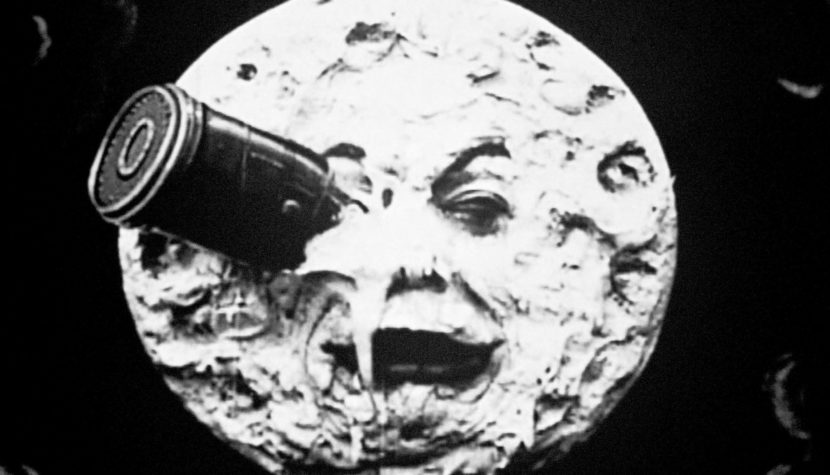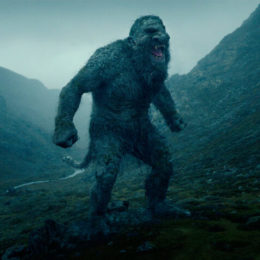A TRIP TO THE MOON. At the dawn of science fiction genre

Science fiction is a genre with a long and rich tradition. To reach its roots, we have to travel back to the beginnings of cinematography. One can even make a bold thesis that it was the first futuristic spectacles shown on the big screen that contributed to the formation of the proper and well-known film art today. The importance of my favorite genre for the development of cinema is therefore considerable. Georges Méliès, the pioneer of cinema, and his most famous work, gave me the reason for drawing these conclusions.
A Trip to the Moon is a less than thirteen-minute film, shot in 1902. And it’s a true classic of cinematography. Every moviegoer has at least once seen the famous frame with the moon face “cut” by a bullet in the eye. In pop culture, this image was permanently stuck – decades later it was used in the music video for Heaven for Everyone by Queen. When A Trip to the Moon is viewed today, while maintaining a contemporary aesthetic perspective, there is no denying that the whole thing looks extremely grotesque. After all, all the elements of the production, led by the pantomime acting, strike the eyes with primitivism. But I like to turn off all my cinematic experiences for these thirteen minutes and look at Méliès’s work from the perspective of the other viewer, who is just learning the magic of the animated image. Then I am inclined to see in the film the potential of being one of the first cinema spectacles.
But let’s start from the beginning. The first public shows of the Lumière brothers, organized in 1895, caused a sensation from the very beginning. The train entering the station could be shocking, as it was an example of the revival of photography, i.e. a previously static matter. But for all their brilliance and breaking down barriers, these makeshift films lacked imaginativeness and magic – elements that would take them beyond the framework of a more perfect documentary form.

One of the spectators of the Lumière brothers’ show was Georges Méliès. In the field of providing entertainment to the audience, he already had a lot of experience, because as a professional illusionist he had his own theater where he entertained the audience with his performances. This allowed him to become fascinated by the possibilities of the cinematograph, as he saw in the new technology a chance to operate the stage illusion even better. The films that he began to shoot in his atelier at first were not much different from what the famous French brothers presented. With time, however, Méliès began to diversify his moving pictures with new elements that today are part of the traditions of film art and are components of its universal language. And, what needs to be emphasized, science fiction gave the French visionary the ground to implement his ideas.
Related:
The director became famous primarily for the implementation of the first special effects in the film. Interestingly, there is an accident involved in their invention. When Méliès was shooting one of his paintings, his camera froze for about a minute while shooting the square. During this time, many filmed people and vehicles changed their location. This resulted in the so-called freeze frames. Upon resuming filming and subsequent screening, it was revealed that the characters on set had switched places. At that time, it brought wide possibilities in the matter of creating screen illusions. The disappearance and reappearance of objects and their copying were supported by other treatments from the visual sphere, such as costumes and decorations. Méliès was also the first to experiment with coloring frames.

We are able to experience all this magic in A Trip to the Moon. But, equally important, Méliès’s film promises to introduce another fundamental element to the art of filmmaking – the plot. Although the Lumière brothers’ Glade Pourer from 1895 already had the features of a plot, it was introduced into the film in its full glory a little later, thanks to Méliès’ thought. How did it go on the trip to the moon? As the title suggests, the film is about the realization of an eternal human desire: going into space. Desires that later constituted the essence of science fiction. The story was based on the motifs of two literary classics of the genre: From the Earth to the Moon by Jules Verne and The First Men on the Moon by H. G. Wells. In this way, the common practice of reaching for the tradition of literature in order to process and visualize its content with the help of a moving image began. And Méliès’ fascination with space was first seen in the 1898 film An Astronomer’s Dream, which today looks like a prelude to what was shown in the expanded form of A Trip to the Moon.
The fantastic journey at Méliès becomes possible thanks to the launch of a huge missile in which traveling scientists could hide (the role of one of them was played by the director himself, who often appeared in his films). They previously planned both the way of the journey and its final destination, i.e. the Silver Globe. On the spot, they meet dangerous natives, who, as it turns out, can be very easily annihilated – because it is enough to touch them with an umbrella. Soon the scientists return to Earth in light of glory, along with one stowaway… This is not a plot that can grab the viewer from today’s perspective. But it is the first implementation of a motif that will remain essential for the genre for years to come. The content also includes an introduction, development and conclusion, which was already enough to stand out and lay the foundations for the formation of a classic, scripted structure.

The breakthrough of the film was already felt on the day of its premiere. After the success of A Trip to the Moon in France, Méliès took the film to the USA to earn money by showing it there. However, there was an unpleasant surprise for him. The pioneer of cinema there, Thomas A. Edison, together with his entourage of technicians, surreptitiously produced a copy of Méliès’s film. The trip to the moon has been shown overseas for several weeks now. At that time, the rule was that what is not forbidden is allowed. Thus, Méliès never earned a penny from the screening of his work in the USA. This was the beginning of the end of his career, which ended in bankruptcy. Méliès then holed up in the toy shop he ran. It was only years later that a journalist accidentally recognized the famous director and decided to remind him once again how important he is to cinematography. On the basis of this story, the film Hugo by Martin Scorsese was created, paying tribute to the great creator.
The assumptions of the genre, whose only limit in creating content is the imagination of the fantastic, were conducive to crossing the boundaries of film vision and implementing pioneering initiatives. A Trip to the Moon had a huge impact not only on later science fiction films, but also on cinema as a whole. The permanent implementation of the film’s plot and diversification with various elements of the visual setting were of great importance for the art of film. Without it, there would be no what we conventionally call “cinema magic”. In the materials devoted to the artist, I came across the phrase: “he found the film a document and left it a spectacle”. And it’s hard to find a better summary of his work, of which A Trip to the Moon is an excellent example.





